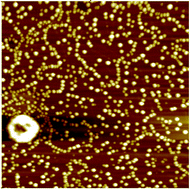当前位置:
X-MOL 学术
›
Catal. Sci. Technol.
›
论文详情
Our official English website, www.x-mol.net, welcomes your
feedback! (Note: you will need to create a separate account there.)
Cobalt and cobalt carbide on alumina/NiAl(110) as model catalysts
Catalysis Science & Technology ( IF 4.4 ) Pub Date : 2017-10-30 00:00:00 , DOI: 10.1039/c7cy01806a Tianfu Zhang 1, 2, 3, 4, 5 , Jingsong Wu 1, 2, 3, 4, 5 , Yuqun Xu 1, 2, 3, 4 , Xiaoping Wang 1, 2, 3, 4 , Jun Ni 4, 5, 6, 7 , Yongwang Li 1, 2, 3, 4 , J. W. (Hans) Niemantsverdriet 1, 2, 3, 4
Catalysis Science & Technology ( IF 4.4 ) Pub Date : 2017-10-30 00:00:00 , DOI: 10.1039/c7cy01806a Tianfu Zhang 1, 2, 3, 4, 5 , Jingsong Wu 1, 2, 3, 4, 5 , Yuqun Xu 1, 2, 3, 4 , Xiaoping Wang 1, 2, 3, 4 , Jun Ni 4, 5, 6, 7 , Yongwang Li 1, 2, 3, 4 , J. W. (Hans) Niemantsverdriet 1, 2, 3, 4
Affiliation

|
Cobalt is an important catalyst for Fischer–Tropsch synthesis, and it can form cobalt carbide under syngas (CO + H2) reaction conditions, especially in CO-rich mixtures. As cobalt carbide has been credited as a promoter which brings about significant selectivity changes in CO hydrogenation, we are interested in studying it using a surface science approach, to understand its interaction with important reaction intermediates. In the present study, we use a NiAl(110) surface to produce a flat alumina film and prepare cobalt and cobalt carbide thereon. We find that cobalt is thermally stable up to 800 K on alumina/NiAl(110). Different preparation temperatures result in different morphologies of the surface. Cobalt carbide is obtained by evaporating cobalt in an C2H4 environment, as proved by the appearance of a C 1s peak at 283.3 eV of carbidic carbon and at 286.2 eV of chemisorbed CO on cobalt carbide in the XPS spectra. Large cobalt carbide crystals with a typical size of 100 nm × 50 nm are revealed by STM. The results show that cobalt and cobalt carbide on alumina/NiAl(110) can serve as suitable model systems for studying structures, adsorption and catalytic properties.
中文翻译:

氧化铝/ NiAl(110)上的钴和碳化钴作为模型催化剂
钴是费-托合成的重要催化剂,在合成气(CO + H 2)反应条件下,特别是在富含CO的混合物中,它可以形成碳化钴。由于碳化钴被认为是促进CO加氢选择性显着变化的促进剂,因此我们有兴趣使用表面科学方法对其进行研究,以了解其与重要反应中间体的相互作用。在本研究中,我们使用NiAl(110)表面产生平坦的氧化铝膜,并在其上制备钴和碳化钴。我们发现钴在氧化铝/ NiAl(110)上的热稳定性高达800K。不同的制备温度导致表面的形态不同。碳化钴是通过在C 2 H 4中蒸发钴而获得的在XPS光谱中,在碳化钴的283.3 eV处和化学吸附的CO的286.2 eV处出现了C 1s峰,证明了这种环境。STM揭示了典型尺寸为100 nm×50 nm的大型碳化钴晶体。结果表明,氧化铝/ NiAl(110)上的钴和碳化钴可以作为研究结构,吸附和催化性能的合适模型系统。
更新日期:2017-11-08
中文翻译:

氧化铝/ NiAl(110)上的钴和碳化钴作为模型催化剂
钴是费-托合成的重要催化剂,在合成气(CO + H 2)反应条件下,特别是在富含CO的混合物中,它可以形成碳化钴。由于碳化钴被认为是促进CO加氢选择性显着变化的促进剂,因此我们有兴趣使用表面科学方法对其进行研究,以了解其与重要反应中间体的相互作用。在本研究中,我们使用NiAl(110)表面产生平坦的氧化铝膜,并在其上制备钴和碳化钴。我们发现钴在氧化铝/ NiAl(110)上的热稳定性高达800K。不同的制备温度导致表面的形态不同。碳化钴是通过在C 2 H 4中蒸发钴而获得的在XPS光谱中,在碳化钴的283.3 eV处和化学吸附的CO的286.2 eV处出现了C 1s峰,证明了这种环境。STM揭示了典型尺寸为100 nm×50 nm的大型碳化钴晶体。结果表明,氧化铝/ NiAl(110)上的钴和碳化钴可以作为研究结构,吸附和催化性能的合适模型系统。











































 京公网安备 11010802027423号
京公网安备 11010802027423号